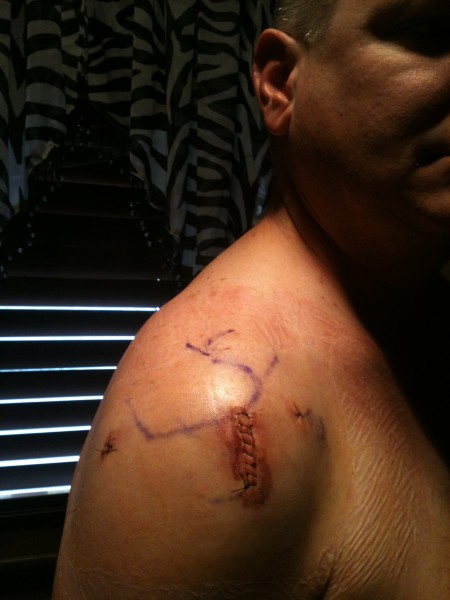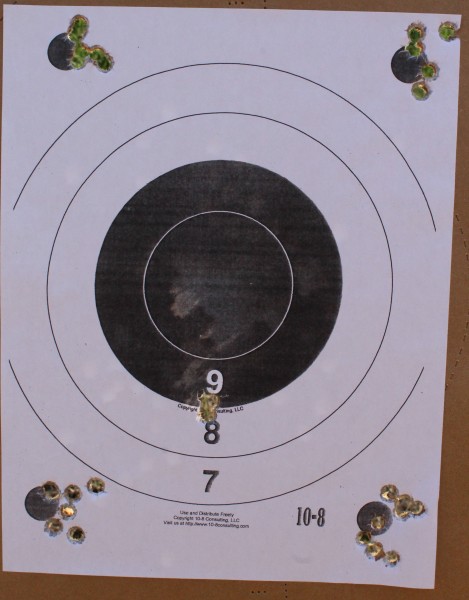A score of eighty-eight percent on our state’s generous law enforcement qualification course is not acceptable in my book. It had been my first attempt that year just over three months out of my second surgery. I can hardly remember a time when I didn’t shoot a perfect or near perfect score on a qualification round. In a nine-month period, I’d had Ulnar nerve surgery on my left elbow and triple surgery on my right shoulder. It’s hard to say which is more responsible for the lengthy recovery time: the injuries and subsequent surgeries themselves or the years of procrastination. Either way, my days of being useful as a real cop were seemingly over.
Physical atrophy is to be expected after a joint surgery (and even in my prime, I was more slight than might), but the real problem for me was the subsequent emotional atrophy. I was under doctor’s orders not to do even a single push-up for at least a year. That meant an automatic failure of the SWAT team’s mandatory P.T. test. I was a team leader and was forced to resign several years before I had planned. At about the same time, I was removed from my primary position as a shift commander and put in an administrative/supervisory role over non-sworn personnel. The cumulative effects of these life changes were devastating beyond physicality.
While researching the topic, I came across the story of an accomplished and renowned firearms instructor who had suffered more than I could imagine through injury and illness. His spirit never wavered. This man is a top shelf firearms instructor and he had to start over from absolute zero. Ralph Waldo Emerson said, “Fractures well cured make us more strong.” As it turns out, that was the first step in what would become a three-step plan to recovery:

Shoulder surgery is all-too-common among middle-aged men but re-attaining one’s shooting skills can be a challenge.
1) Emotional Recovery
Anyone using the term, “bootstraps” to me during this period may have been met with ire. It just isn’t that easy. Cops hate to admit that they are affected by emotion or even have feelings. In fact, we come up with facetious synonyms for the word so we don’t have to actually say it. Recognize that those, “feelers” that you have of being a diminished version of your former self are temporary and will be overcome with time. Most importantly, accept where you are, but never accept that’s where you will always be. Discussing the matter with someone who has been there can be invaluable.
2) Physical Recovery
Secondly, go into the gym and not only do those horrific physical therapy exercises, but also others not included in the program like cardio, legs and core workouts, in my case. I couldn’t do much upper body work outside of the prescribed physical therapy work without experiencing painful setbacks. However, the total systemic progress I got from core and lower body work was very helpful in my long term recovery. Others with leg injuries can benefit from upper body workouts. Just be careful not to get too aggressive with the muscle groups and joints near the injury. If the doctor or physical therapist told you to only do dumbbell rows at 25% of the weight you were using before your injury, do that. Using 50% might just buy you a setback. Don’t try to sneak in some light bench work, if you were advised against it. Ask me how I know. Also, while in the gym, you may need to ignore those furtive, judgmental glances from “Sven the Grunter” as you do your reps with embarrassingly light weight. His experiences are different than yours.
3) Skills Recovery
The last part of the process is regaining your physical shooting skills. Retraining myself did not get the desired results. At this point, I had lost my shooting fundamentals. I was eye-sprinting, jerking the trigger, anticipating recoil and just generally shooting like a newbie. On the draw stroke, I had begun to instinctively tuck my elbow inward to avoid what had become an all-to-familiar wincing pain. That caused a “fly fishing” motion. In other words, as my elbow naturally tucked inward, the pistol’s muzzle was forced upward making a proper “press-out” impossible. I had to add a correcting motion to my draw stroke to get the gun back on target, which is not good.
I worked on the issue relentlessly. However, even after the pain faded, I couldn’t fully overcome it. That is until I saw the “Window Drill” technique set forth here on Modern Service Weapons by our own Jerry Jones. You never know when something small like that can make a big difference. I enrolled in some classes and absorbed all I could, but most definitely didn’t make the showing that I would have hoped. Even the tenure of two decades in law enforcement couldn’t keep me from feeling and acting like a goofy, awkward rookie. Still, it was worth it. That exposure to new training reinvigorated me in both in mind and body. After several months of slow and consistent work in these three areas, I began to see improvement. In time, I was able to draw and “put rounds on target,” at a reasonable speed and my qualification scores became more acceptable.
No matter what the injury, the recovery probably won’t come quickly or easily. Start from the fundamentals and work your way back up slowly. I write this nearly two years after the second operation and I’d say my recovery is at about 80%, but I can see 100% from here. In fact, I can see beyond it. The fracture may out of our control. Whether or not it is well cured most certainly is.




Great post. I’m almost 49, and have been carrying a fairly serious shoulder injury for a year and a half. I can still workout, but I have to be very careful with exercise selection and intensity. I’ve been pretty gun-shy about surgery, but I’m finally starting to recognize that surgery maybe the best path forward if I want to remain active and fit. Congrats on your ongoing recovery, and thanks for sharing your experience.
I feel your pain, i had a torn patellar tendon and two more seperate knee surgeries since that one, stick with it, over time it gets better…